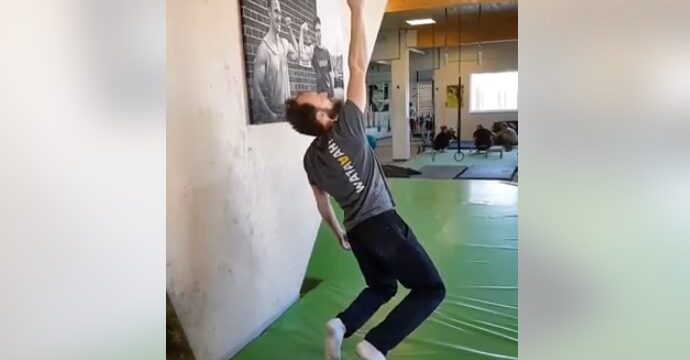Image source – Ben Hardy 44s one arm middle rung BM2k hang
Essentially, the point I’m trying to drive home with this article is understanding things like finger strength in terms of limiting factors. My analysis is not mutually exclusive with the fact that hand strength is strongly correlative.
Common question are: “What must I do to get to a certain climbing ability?” For instance, one arm hanging the bottom middle rung of the BM2K is widely considered to be “V10 hand strength.” Even hangboard articles make this mistake:
In all of the strength metrics measured by climbing coaches, the only one which has a strong correlation with the ability to boulder 8A (V11) is whether or not the climber can hang an 18mm edge with 1 arm.
This type of thinking is very deceptive to climbers that are weaker. What this means (for climbers that are weaker) is that if they get the same level of hand strength it is NOT a limiting factor (rather than a commonality that all V10 or V11 climbers should get to).
Consider:
- A V8 climber who can one arm the BM2K bottom middle rung is definitely not limited by hand strength
- A V9 climber who can one arm the BM2K bottom middle rung is not limited by hand strength
- A V10 climber who can one arm the BM2K bottom middle rung is probably not limited by hand strength
- A V11 climber who can one arm the BM2K bottom middle rung (but not a smaller rung) may be limited by hand strength
On the other hand:
- A V9 climber who can’t one arm the BM2K bottom middle rung perhaps may be limited by hand strength
- A V10 climber who can’t one arm the BM2K bottom middle rung may be limited by hand strength
- A V11 climber who can’t one arm the BM2K bottom middle rung is very likely limited by hand strength
- A V12 climber who can’t one arm the BM2K bottom middle rung is almost definitely limited by hand strength
The main point is that BM2K as a standard for V10 hand strength or 18mm V11 means that it’s not a limiting factor at that point.
If you can’t do it as a stronger than V10 climber you can be limited by hand strength. If you can do it as a weaker climber than V10 climber, you’re probably not limited by hand strength.
These standards do not mean that you can climb that grade. They mean that when you hit that certain standard it’s not a weakness. If you get to these “standards” and you still cannot climb those grades, your climbing is definitely being limited by other factors rather than hand strength. You have more than sufficient hand strength but probably less than sufficient other areas.
This post is about understanding the utility benchmarks provide, not that benchmarks are bad.
- It’s great to work toward benchmarks.
- If you hit benchmark it’s not a weakness or limiting factor anymore.
- If you still can’t send in that grade range, you likely have other weaknesses you need to work on. Find them and work on them.
Since this article has been released, there have been companies like power company climbing and lattice who have gotten more data on how things like hangboard, weighted pullups, and such things correlate to climbing ability.
https://www.powercompanyclimbing.com/blog/climb-harder-data
Generally, I’d say this would be an adequate way to assess a potential weakness and work on it.
- If you’re < 10th percentile it’s almost definitely a weakness
- If you’re < 25th percentile it’s probably a weakness
- If you’re = 50th percentile it can be a weakness
- If you’re > 75th percentile it’s probably not a weakness
- If you’re > 90th percentile it’s definitely not a weakness
Generally, mainly work the low hanging fruit which is the < 10th and < 25th percentile metrics.
Notes: This article has been modified significantly from its original incarnation.
Author: Steven Low
Steven Low is the author of Overcoming Gravity: A Systematic Approach to Gymnastics and Bodyweight Strength (Second Edition), Overcoming Poor Posture, Overcoming Tendonitis, and Overcoming Gravity Advanced Programming. He is a former gymnast who has performed with and coached the exhibitional gymnastics troupe, Gymkana. Steven has a Bachelor of Science in Biochemistry from the University of Maryland College Park, and his Doctorate of Physical Therapy from the University of Maryland Baltimore. Steven is a Senior trainer for Dragon Door’s Progressive Calisthenics Certification (PCC). He has also spent thousands of hours independently researching the scientific foundations of health, fitness and nutrition and is able to provide many insights into practical care for injuries. His training is varied and intense with a focus on gymnastics, parkour, rock climbing, and sprinting. Digital copies of the books are available in the store.
